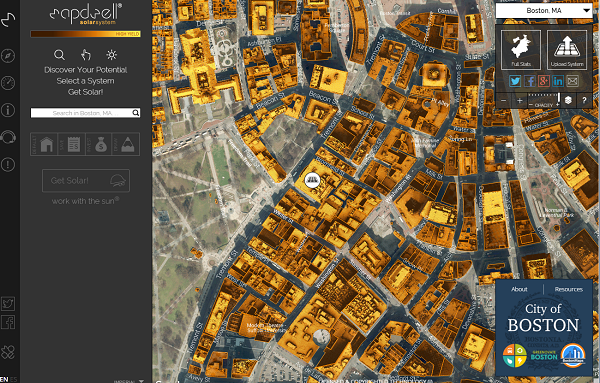For the average homeowner, there’s more benefit to going solar than ever before. But most people still find the whole idea too intimidating to take action. That’s where Mapdwell, a spin-off company from MIT that is creating incredibly detailed maps of the solar potential for each and every building in various cities, comes in.
Solar energy is becoming a worldwide boom with Germany leading most industrialized nations in terms of solar readiness and available policies in support of the technology. Other countries such as Spain and France are also quickly catching up.
France recently announced it will pave a thousand kilometers of roads with solar panels. If the project is implemented successfully, it could supply 5 million people with solar electricity; approximately 8% of France’s population.
Across the pond in the U.S., 1,361 megawatts (MW) of solar photovoltaics (PV) was installed in the second quarter of 2015 to reach 24.1 gigawatts (GW) of total installed capacity, enough to power 5 million American homes. The country has about 4.3 million kilometers of paved roads; including 76,334 km of expressways.
Wouldn’t it be cool to have these roads paved using solar panels?
Its a good thing the solar roadways technology is quickly coming out of R&D and testing phase. So in the near future, we could see this technology being implemented on a real road.
The huge success of the U.S solar sector in 2015 can be credited to a booming residential solar market. With this continued growth, it becomes very necessary for solar enthusiasts and proponents like myself to identify and share tools to help homeowners make the decision to go solar.
So I get very excited when new technology supporting this movement pops-up and is creating buzz.
That said, I’d to share a new technology that was previously developed by MIT researchers and that has now been spun into a startup. It is an online tool—basically an interactive map—that shows property owners how much electricity they can produce on their rooftops from solar photovoltaic (PV) systems.
It also provides information on how the financial investment will pay off and how much pollution will be reduced. The technology has been found to predict electricity yield to within 4-10 percent of actual measured results.
The website or tool is called Mapdwell.
MIT news reports in a recent article that the co-founder and technology co-inventor Christoph Reinhart, an associate professor of architecture and head of the MIT Sustainable Design Lab—partnered with co-founder and current CEO Eduardo Berlin, a former colleague at Harvard University whose research centered around information-driven models for sustainability in the real estate market—to work on—and launch the startup.
“Solar energy has all this baggage, in a way. Solar panels have been out there for 30 to 40 years, but most homeowners still believe panels are “complicated, expensive, not-for-me kinds of things,” says CEO Eduardo Berlin. “Solar is a real possibility for many people now, but somehow that got missed. It never got rebranded. The idea that you can put something on a roof and create energy from the sun, it’s pretty amazing.”
MIT news added in the same article—that Berlin worked on the company’s plan and the platform’s concept and design, including the popular color-coded dots.
“You get real dollar amounts, which adds to the value of the system, but people process graphical information better than numbers,” Reinhart says. “That color scheme is incredibly important and seductive.”
The technology behind this toll was first announced in 2012 and was limited only to the city of Cambridge in Massachusetts. Although still limited to only a few cities, the technology has grown to add eight cities across the U.S., including New York, San Francisco, and three in Massachusetts — Boston, Cambridge, and Wellfleet—as well as a few cities in Chile.
Why Chile in particular? I have no idea. Rest assured it is currently expanding to include all major metropolitan areas in the U.S. by year’s end.
The idea is to “empower businesses and homeowners with information they need to go solar,” according to the Mapdwell website.
This platform could prove to be an incredibly useful tool in promoting a transition to solar energy in both an individual and community level. Interestingly, the Mapdwell platform also provides very detailed statistics on the solar yield for entire cities, which could be a useful metric when municipalities are trying to decide whether to promote solar energy.
“Results from mapped cities indicate that, in general, solar panel installation is a good investment for long-term homeowners,” Reinhart told MIT News. “In Cambridge, for example, a good roof will get you your money back within seven years,” he says.
Won’t you agree with me that these guys deserve a “thumps up” for creating such an awesome platform?
But then the challenge is: How can you get people interested? How can you get people informed and excited about this technology? That is the important question.















Comments